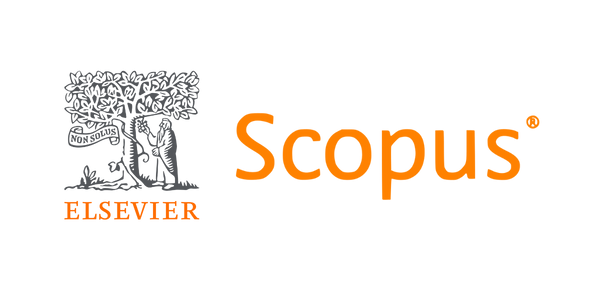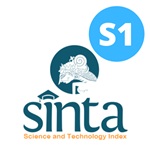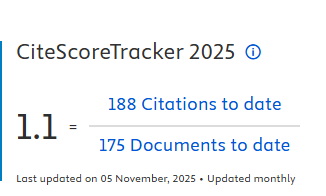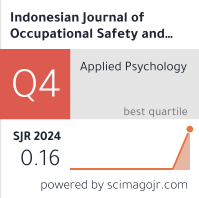RISK ASSESSMENT KECELAKAAN KERJA PADA PENGOPERASIAN BOILER DI PT. INDONESIA POWER UNIT PEMBANGKITAN SEMARANG
Downloads
Boiler is a tool produced steam. The operation of boiler produce hazard that can cause accidents in labor. The purpose of this research is to risk assessment for accidents work in the operation of boilers in PT. Indonesia Power Unit Pembangkitan Semarang. This research is observational. The object of this research is boiler. The subject of this research is coordinator and operator boiler. The primary data was obtained from observation and interview, while secondary data from the corporate documents. The result showed that boilers in PT. Indonesia Power Unit Pembangkitan Semarang were 3 unit of water tube using fuel MFO and HSD. The identification hazard obtained 12 findings hazard on 9 areas the operation boiler PT. Indonesia Power unit Pembangkitan Semarang. The hazard in the area of boiler are noise, hot weather, fire sparks, hit, pinched hand, discover water vapor, high pressure, electricity, contact with a steam pipe, amount of oil, exposed NaOH liquid, and slip and fall down from the height. On controlling value, there were 6 hazards that classified as in very good control, 3 hazards were classified as partly implemented, and 3 hazards were classified as implemented. The residual risk was obtained 5 category risk with no risk and 7 risk categories low. Conclusion that can be drawn are hazard boiler in PT. Indonesia Power Unit Pembangkitan Semarang have high risk of are hazard discover water vapor and the high pressure. The company suggested to perform maintenance and reduce the risk to a low.
Keywords: risk assessment, work accidents, boiler
Australian/New Zealand Standard, AS/NZS 4360. 2004. Risk Management Standards. New Zealand: Council of Standards Australia and Council of Standards.
Darmanto, S., Rahmat., Setyoko, B., 2007. Peluang Penghematan Energi Uap Menggunakan Metode Non-Investment Point. Jurnal unimus.ac.id, 5(1):
–40.
Departemen Tenaga Kerja dan Transmigrasi RI. 1970. Undang-Undang No.1 Tahun 1970 Tentang Keselamatan Kerja.
Departemen Tenaga Kerja dan Transmigrasi RI. 1930. Peraturan Uap.
Fatoni, R. 2013. Rekomendasi Standar Sistem Keselamatan untuk Steam Boiler di Pabrik Tahu. Simposium Nasional Teknologi Terapan(SNTT), ISSN 2339-028X.
Fauzy., Rusdhianto, E., 2012. Desain Kontroler PID Fuzzy Untuk Pengendalian Tekanan dan Level Oksigen Gas Buang pada Boiler. Jurnal Teknik POMITS, 1(1):1–6.
Kristianingsih, L., Ali, M. 2013. Analisis Safety System dan Manajemen Risiko pada Steam Boiler PLTU di Unit 5 Pembangkitan Paiton, PT. YTL. Jurnal Teknik POMITS, 2(2): 356–361.
PT. Indonesia Power Unit Pembangkitan Semarang. 2003. Gambaran Umum Perusahaan Indonesia Power. Semarang : PT Indonesia Power UP semarang.
Radiyan, M. 2014. Risk Assessment and Risk Management pada Pengoperasian Pesawat Uap di PT Japfa Comfeed Indonesia Tbk Unit Gedangan. Tugas Akhir. Surabaya: Universitas Airlangga.
Rambe, A. 2003. Gangguan Pendengaran Akibat Bising. Jurnal kedokteran. Sumatera Utara: Universitas Sumatera Utara.
Siswanto, A. 2009. Risk Management. Surabaya: Balai Hiperkes dan Keselamatan Kerja Jawa Timur.
Tawatsupa, B., dkk., 2012. Association Between Heat Stress And Occupational Injury Among Thai Workers: Findings of The Thai Cohort Study. Industrial Health Journal [Online Journal] 2012; [Sitasi 25 Juni 2016] http://www.jniosh.go.jp/en/ indu_hel/pdf/ IH_51_1_34.pdf.
Veasey, D., Lisa C., Barbara M. 2002. Confined Space Entry and Emergency Response. United States of America: The McGraw-Hill Compenies, Inc.

In order to be accepted and published by The Indonesian Journal of Occupational Safety and Health, Author(s) who submit an article should complete all the review process. The copyright of received articles assigned to the The Indonesian Journal of Occupational Safety and Health and Department of Safety and Health, Universitas Airlangga as publishers of the journal. The intended copyright includes the rights to publish articles in various forms (including reprints).
The Editorial Team of The Indonesian Journal Of Occupational Safety and Health and Department of Safety and Health strive to ensure that no errors occur in the articles that have been published, both data errors and statements in the article.
Users of this website will be licensed to use materials from this website following the Creative Commons Attribution-NonCommercial-ShareAlike 4.0 International License. No fees charged. Please use the materials accordingly.
------------------------------------------------------------------------------------------------------------------------------------------------------------------------------------------
Attribution ” You must give appropriate credit, provide a link to the license, and indicate if changes were made. You may do so in any reasonable manner, but not in any way that suggests the licensor endorses you or your use.
NonCommercial ” You may not use the material for commercial purposes.
ShareAlike ” If you remix, transform, or build upon the material, you must distribute your contributions under the same license as the original.







 How to Submit Articles in OJS
How to Submit Articles in OJS

























